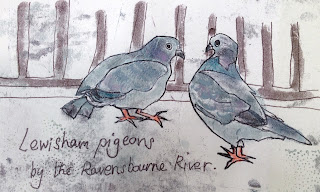I haven't written anything on this secondary blog for a while now, but we have been to birder's paradise in the last two weeks. Northumberland and now Scotland.
Day 1 in Northumberland and we're off to see the Pacific golden plover that has been hanging around the headland at Boulmer. I didn't mind going to see this, Boulmer beach turns out to be beautiful and the dunes are full of wild flowers. We walk to the headland and it's obvious something has indeed turned up. I happily stand there looking at a beautiful bird that has turned up in the wrong place, as the name suggests. I am sad thinking about it being there on its own without a friend. The headland is full of curlews (my favourite bird), golden plovers, knot, dunlin, terns (Common, Artic, Roseate, Sandwich). Today (August 21st) I learn that the Pacific Golden Plover has moved on, to somewhere down the coast.
This was the view as we rounded the headland, at least we knew we were in the right place.
 |
Add caption
|
We got on a boat to the Farne Islands and saw some puffins on the sea ,by this time they are moving on to who knows where, having already raised their chicks. There were lots of kittiwakes and shags, who are amusing to watch. There were also lots of grey seals, looking at us curiously from the sea.
THE TICK.........
Now, moving on to the main attaction, wait for it.... the Greenish warbler. Sounds made up to me, but over to Lindisfarne we go, to find said bird. It is in some willows apparently. Mr Birder has some vague instructions to follow. We race up a path to some willows and realise with some frustration these are the wrong ones. Birder is anxious; he can't see any other twitchers. I am slightly irritated. I walk ahead and find a chap with binoculars who is sure the bird has been seen in different willows round the bend of the path. I phone Mr Birder who catches up. Again, no other birders about, which is strange for a rare bird alert. We race on, me stopping to look at wild flowers in the duney landscape. Finally, we see a man with binoculars who tells us we need to be further round altogether, not far from where we were to start with. Showing well apparently!! At last we arrive at the willow, where there is another birder who has just arrived, hopeful. Telescope is set up and there it is!! We think. Two more birders arrive and set up their telescopes. Yes, there's the Greenish warbler, but what does the supercilium look like? The first birder and I admit to not knowing what a supercilium is. We find out.
https://en.wikipedia.org/wiki/Supercilium.
What about the wing bar though? Nobody can be sure that it is the right bird until the wing bar has been identified. Yes, there's the wingbar. I am invited to look through one of the telescopes and there it is, a rather lovely little green (yes!) bird with a defined supercilium and a wing bar that is correct ad in place.
and here is the twitch!!









